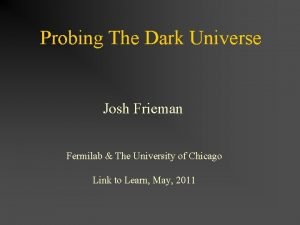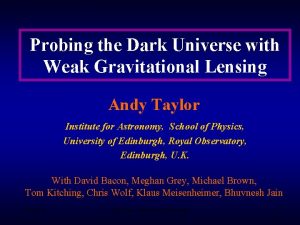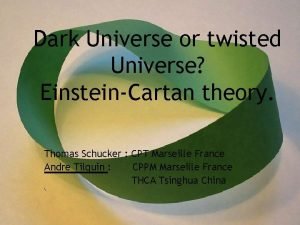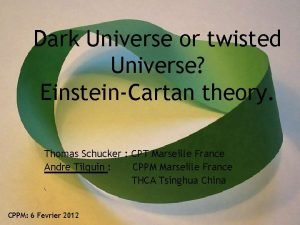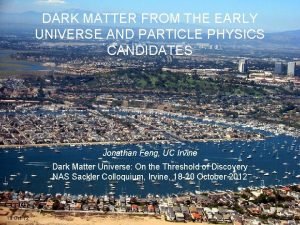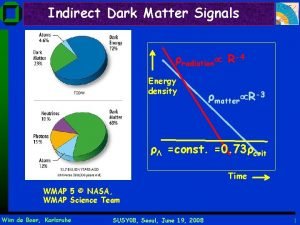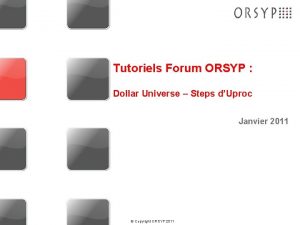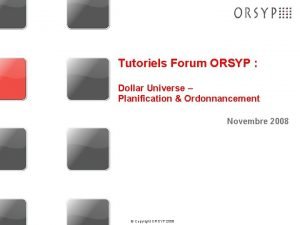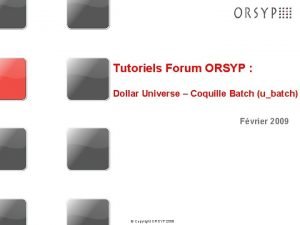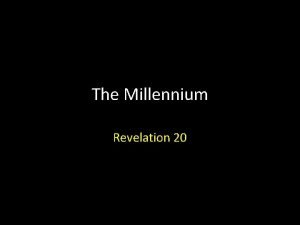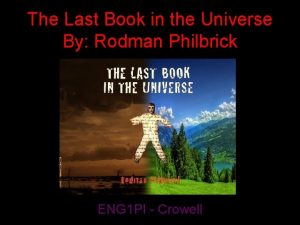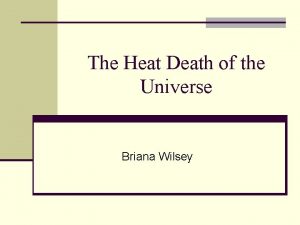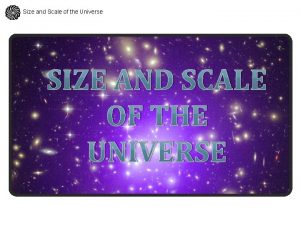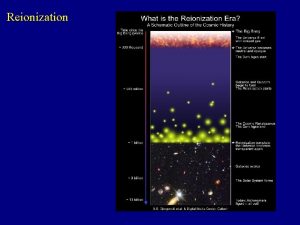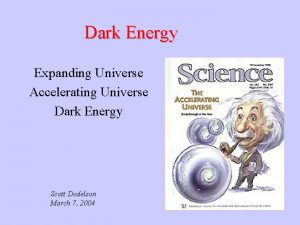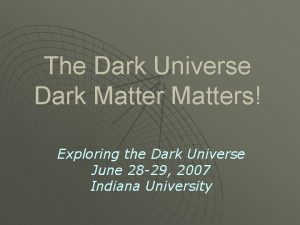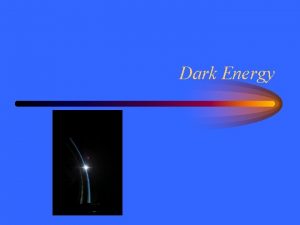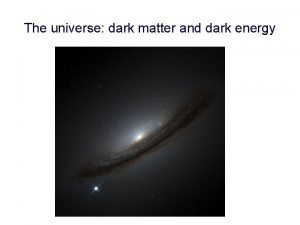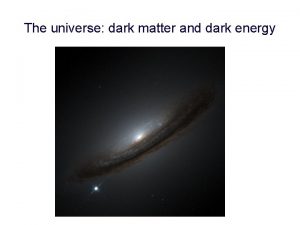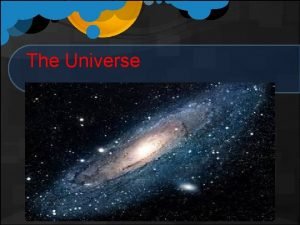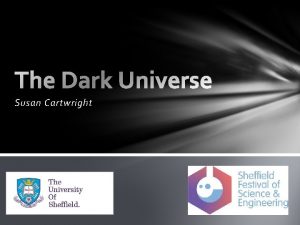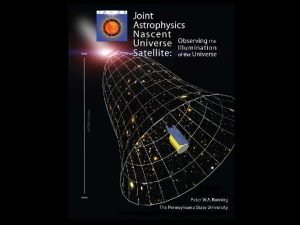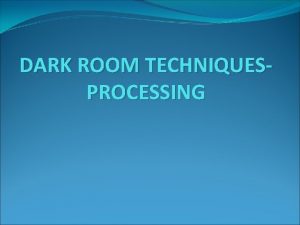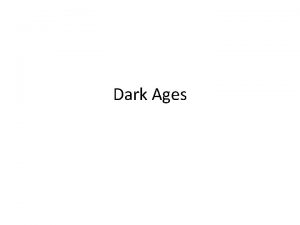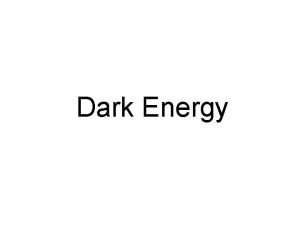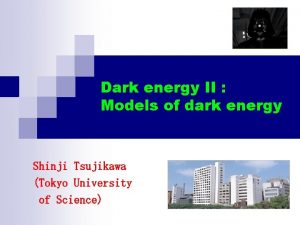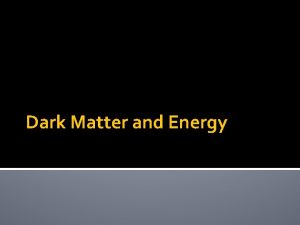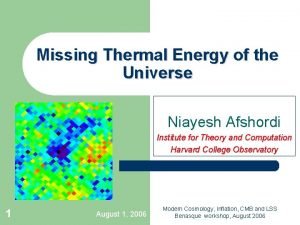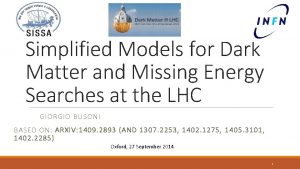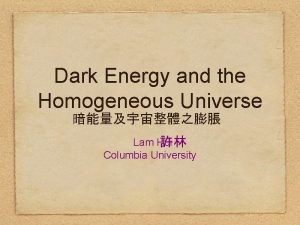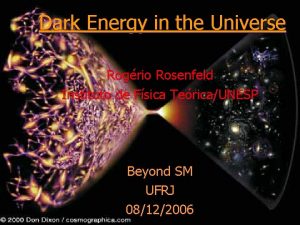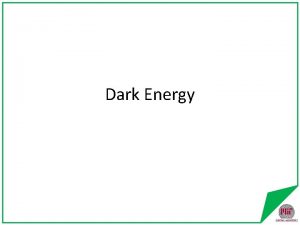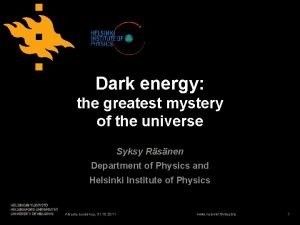Dark Energy The missing 70 of the Universe






























































- Slides: 62

Dark Energy: The missing 70% of the Universe Brenna Flaugher Fermilab 1

Cosmic Pie Dark Energy is the dominant constituent of the Universe Dark Matter is next 95% of the Universe is in Dark Energy and Dark matter for which we have no understanding 1998 and 2003 Science breakthroughs of the year 2

Outline § A few definitions and concepts § Cosmology today § Evidence for Dark Matter § Evidence for Dark Energy § Targeted Dark Energy Project: The Dark Energy Survey § Science plans § Instrumentation 3

Revelations of the past decade: Dark Matter and Dark Energy Most of the Mass in the Universe is DARK – we can’t see it Dark Matter: any matter whose existence is inferred solely from its gravitational effects (i. e. , does not emit light) It also turns out that just summing up the matter (dark and luminous) does not agree with the observed expansion rate of the universe Dark Energy: some sort of energy whose existence is inferred from expansion rate of the universe Two broadly defined approaches to constraining DM and DE: Measure the expansion rate of the universe Measure the rate of growth of structures in the universe (e. g galaxies and galaxy clusters) 4

Cosmology as we understand it now Us, Now 5

The Universe is expanding 6

Redshift = z Cosmic Scale Factor 1+z = a(t 0)/a(te) = (t 0)/ (te) radius a(t 1): 2 -D Analogue t 0 = age of U today te = age when light was emitted The redshift is an indication of age and distance: z = 0 here and now z = 1000 for the oldest photons, originating from the most distant place we can see (CMB) radius a(t 2) 7

Measuring redshifts with spectra receding slowly Galaxy Emission Lines are stretched to higher wavelengths as redshift increases z ~ / e receding quickly 8

New (2003) picture of the young universe Right after the Big Bang the photons, p, and e were in thermal eq. - a big cloud Once things cooled off a bit, H formed and the photon interactions slowed way down – meaning the photons got away – these are the CMB photons CMB radiation density field at z ~ 1000 when the Universe was ~400, 000 years old WMAP Red: 2. 7+0. 00001 deg Blue: 2. 7 -0. 00001 deg Scale of the Observable Universe: Size ~ 1028 cm Mass ~ 1023 Msun These small anisotropies in the CMB are temperature differences that could evolve into the structures (e. g. galaxies, and galaxy clusters) we see now. 2006 Nobel Prize in Physics was for the 1 st measurement of this (1992, COBE) 9

Measurement of the old universe (~ today) Sloan Digital Sky Survey (SDSS) measures the galaxy density field out to z ~ 0. 3 Overdense regions are visible These are clusters of galaxies z=0 Voids and filamentary structure also evident Note – the sample density drops off with z: fainter, harder to see z=0. 3 ~ conversion from redshift to years: [z/(1+z)]*13. 7 yrs z = 0 is Now z = 0. 3 ~ 3 billion yrs ago 10

Simulation of the evolution of the Universe z>30 z=0 ~ conversion from redshift to years: [z/(1+z)]*13. 7 Byrs z = 30 is about 13. 2 billion years ago (in the “dark ages”) z = 0 is now The of growth of structure: is determined by the initial conditions (CMB), the amount and distribution of dark matter, dark energy and the expansion rate of the universe The “discovery” of dark energy came from measuring the expansion rate of the universe with type 1 A supernovae Recent experimental and theoretical progress includes probes based to growth of structure too - different systematics, both theoretical and experimental, will provide new and tight constraints Next few slides describe the evidence for DM and DE 11

Evidence for Dark Matter: Two different observations Dynamical evidence for Dark Matter: DM affects the motions of gas and stars (in galaxies) and galaxies themselves (in clusters) Lensing evidence for Dark Matter: DM curves spacetime and thus bends light rays coming from background sources 12

Galaxies: The Visible Part of our Universe 13

R v v 2 G MGALAXY R = R 2 measure v & R MGalaxy 14

v (km/s) Galaxy rotation curves Observed Mass ~ R 100 Expected if the mass of the galaxy = the mass of the stars, v 2 ~ 1/R 50 5 10 R (kpc) Some sort of Mass must extend out ~10 times further than the stars! out the Science “Through Vera Rubin (Check out. Check the Science Channel Series. Channel “Throughseries the Worm Hole”!! the Worm Hole” with Morgan Freeman! 15

The same is true for clusters of galaxies: if you measure the velocities of the visible galaxies in a cluster, you find that ~ 90% of the mass of the cluster is not visible Identification of galaxy clusters is remarkably similar to jet clustering in collider physics but also have depth (red shift) info. /confusion The big questions: who is in, who is out, what is the mass (and redshift) ? Cluster of Galaxies: Largest gravitationally bound objects Size ~ 1025 cm ~ Megaparsec (Mpc) ~ 3. 2 Million light years Mass ~ 1015 Msun SDSS data 16

Einstein and General Relativity Matter affects the structure of Space-Time A massive object (star, galaxy, cluster of galaxies) attracts nearby objects by distorting spacetime Light follows lines of spacetime: Large clumps of Mass (dark and visible) curve spacetime and thus bend light like a lens Light rays coming from sources behind clumps of matter (such as a galaxy cluster) will be bent and distorted (“lensed”) 17

Gravitational Lensing Geometry Gravitational Lensing: multiple images or pronounced distortion of images Great book: Einstein’s Telescope: the hunt for Dark Matter and Dark 18 Energy in the Universe by Evalyn Gates (U. Chicago)

Zoom in on a galaxy cluster – Gravity is bending light. There must be a lot of gravity (dark matter) beyond the visible galaxies in the cluster giant arcs are galaxies behind the cluster, gravitationally lensed 19

Dark Energy I. Direct Evidence for Acceleration Brightness of distant Type Ia supernovae: Standard candles measure magnitude and distance d. L(z) sensitive to the expansion history H(z) Found that distant supernovae are not as bright as they should be: –> the universe is expanding faster than expected II. Evidence for `Missing Energy’ CMB Flat Universe: 0 = 1 Add up all the visible and Dark Matter matter density m 0. 3 missing = 1 – 0. 3 = 0. 7 = DE Can’t see it and it is pushing the universe apart so call it “dark energy” 20

Type Ia Supernovae are a type of Standard Candle A white dwarf star, accreting mass from a companion star, exceeds a critical mass (Chandrasekhar) and explodes. These explosions are billions of times brighter than our sun. The peak brightness of these type of explosions is standardizable and thus can be related to its distance. There is about 1 SN every 50 years in the Milky Way. Explosions are usually visible for about 40 -60 days. Cepheid Stars are another type of standard candle, their period T is proportional to luminosity, they are about 30, 000 times brighter than our sun – Hubble used Cepheids to derive Hubble’s law (v = Hd) in the 1920’s: 21

Observation of Supernova requires repeated observations of the same area of sky and detailed measurement of the differences as a function of time (typically over ~ 60 days) 22

Type 1 a Supernovae happen when a white dwarf star, accreting mass from a companion star, explodes when it exceeds a critical mass (Chandrasekhar) Once corrected for known effects, the peak magnitudes of all Type Ia Supernova are the same. Luminosity Type Ia Supernovae Peak Brightness Is `Standardizable’ Candle Redshifts can be determined from measurement of the spectra SN Ia are very bright (~14 magnitudes brighter than cepheids) and thus can be seen much farther away (higher redshift) Time 23

24

Hubble Space Telescope: Measured 240 Cepheids over 7 galaxies 6 of the galaxies also had type Ia supernovae Modern value: H 0 = 72 +/ 8 km/sec/Mpc 25

Apparent Brightness Fainter 42 SNe Ia Two groups observed that SNIa are fainter than expected in a non-accelerating universe distance m(z) = M+5 log(H 0 d. L)=(1+z) dz’/H(z’) 26

Dark Energy Brightness of distant Type Ia supernovae, along with CMB and galaxy clustering data, indicates the expansion of the Universe is accelerating, not decelerating. Expansion rate of the universe: H 2(z) = H 20 [ M (1+z) 3 dark matter + DE (1+z) dark energy 3 (1+w) ] (flat Universe, const. w, w = -1: cosm. const. ) This requires either a new form of stress-energy with negative effective pressure or a breakdown of General Relativity at large distances: DARK ENERGY Characterize by its effective equation of state: w = p/ and its relative contribution to the energy density of the Universe: DE Current Status: (w) ~ 0. 15*, w < – 0. 76 (95%) from CMB+LSS+SNe; no single dataset constrains w better than ~30%, and this is for constant w! 27

Key Experimental Questions 1. Is DE observationally distinguishable from a cosmological constant (w =-1)? A cosmological constant means the energy density is constant although universe is expanding. 2. Can we distinguish between gravity and stress-energy? Compare measurements that are sensitive to expansion rate to measurements that are sensitive to growth of structure 3. Does dark energy evolve: w=w(z)? parameterize DE evolution as w(z) = wo + wa(1 -a) 28

Simulation of the evolution of the Universe z>30 z=0 The of growth of structure is determined by the initial conditions (CMB) and amount and distribution of dark matter, dark energy and by the expansion rate of the universe. The project I am working on is the Dark Energy Survey. We will measure the effects of Dark Energy and Dark Matter 4 different ways and by combining the results we hope to get a better understanding of what they are Sensitive to gravity and expansion rate 1) Count the Galaxy Clusters as a function of red shift and cluster mass Sensitive to expansion rate not gravity 3) Measure the spatial clustering of galaxies as a function of red shift; this is a standard ruler (Baryon Acoustic Oscillations) 2) Measure the distortion in the apparent shape of galaxies due to intervening galaxy clusters and associated clumps of dark matter (Lensing) 4) Use Supernovae as standard candles to measure the expansion rate 29

The Dark Energy Survey (DES) • • The Deal: • DES Collaboration provides a state-of-the-art instrument and data system for community use • NOAO (NSF) allocates 525 nights of 4 m telescope time during Oct. –Feb. 2011 -2016 • DES Collaboration performs a 5000 sq deg. survey and makes the data public after a year! New Instrument (DECam): • • Replace the PF cage with a new 2. 2 FOV, 520 Mega pixel CCD camera + optics Collaboration Funding: • DOE, NSF, STFC (UK), Ministry of Education and Science (Spain), FINEP (Brazil), and the Collaborating Institutions Use the Blanco 4 m Telescope at the Cerro-Tololo Inter-American Observatory (CTIO) 30

The DES Instrument: DECam Focal Plane 3 sq. deg. field of view (~ 0. 5 meter diameter focal plane) 62 2 kx 4 k Image CCDs: 520 MPix 8 2 kx 2 k Alignment/focus CCDs 4 2 kx 2 k Guide CCDs 31

Prime Focus Cage and the Blanco Telescope Built in the 1970’s A big solid telescope, ~ 15 tons at the top end People used to ride in the Prime Focus cage and aim/drive the telescope Pictures were taken on glass negatives In Mid-late 80’s digital camera technology (CCDs) started to be used on telescopes By mid 90’s these were the standard, but very expensive. The Blanco currently has a 64 MPixel Camera (8 2 k x 4 k CCDs) 32

The Dark Energy Survey Science • Study Dark Energy using 4 complementary* techniques: Blanco 4 -meter at CTIO I. Cluster Counts: N(M, z): Measure red shifts and masses of 30, 000 clusters to z=1 with M > 2 x 1014 M II. Weak Lensing: 300 million galaxies with shape measurements over 5000 sq deg. III. Baryon Acoustic Oscillations : angular correlation function of 300 million galaxies to z = 1 IV. Supernovae: ~2000 SN Ia, z = 0. 3 -0. 8 • Two multiband surveys: 5000 deg 2 g, r, i, z 15 deg 2 repeat (SNe) *in systematics & in cosmological parameter degeneracies *geometric+structure growth: test Dark Energy vs. Gravity 33

Photometric Redshifts (Photo-z’s) Elliptical galaxy spectrum • Measure relative flux in multiple filters: track the 4000 A break • Estimate individual galaxy redshifts with accuracy (z) < 0. 1 (~0. 02 for clusters) • Precision is sufficient for Dark Energy probes, provided error distributions well measured. • Good detector response in z band filter needed to reach z>1 34

Galaxy Photo-z Simulations DES +VHS* 10 Limiting Magnitudes g 24. 6 J 20. 3 r 24. 1 H 19. 4 i 24. 0 Ks 18. 3 23. 9 Zz 23. 8 Y 21. 6 +2% photometric calibration error added in quadrature Key: Photo-z systematic errors under control using existing spectroscopic training sets to DES photometric depth: low-risk DES gri. ZY griz +VHS JHKs on ESO VISTA 4 -m enhances science reach *Vista Hemisphere Survey PI: R. Mc. Mahon, Cambridge DES collaborator (approved by ESO 11/06) +Developed improved Photo-z & Error Estimates and robust methods of outlier rejection 35

I. Clusters and Dark Energy • Analysis 1. Understand formation of dark matter halos 2. Cleanly select massive dark matter halos (galaxy clusters) over a range of redshifts 3. Redshift estimates for each cluster 4. Observable proxy that can be used as cluster mass estimate: O =g(M) Number of clusters above observable mass threshold w = 1 Primary systematic: Uncertainty in bias & scatter of mass-observable relation 36

Cluster Cosmology with DES 3 Techniques for Cluster Selection and Mass Estimation: • Optical galaxy concentration • Weak Lensing • Sunyaev-Zel’dovich effect (SZE) Ø Ø Compton upscattering of CMB photon by hot gas in clusters gives measure of Mass, nearly independent of redshift South Pole Telescope is measuring cluster masses now in the DES survey area Compare these techniques to reduce systematic errors Additional cross-checks: shape of mass function; cluster correlations 37

II. Weak Lensing Dark matter halos Background sources Observer 38

Statistical Weak Lensing Calibrates Cluster Mass vs. Observable Relation Cluster Mass vs. Number of galaxies they contain SDSS Data Preliminary z<0. 3 Statistical Lensing eliminates projection effects of individual cluster mass estimates For DES, we will use this to independently calibrate SZE vs. Mass Johnston, Sheldon, et al Johnston, etal astro-ph/0507467 39

Weak Lensing: Cosmic Shear Distortion Matrix Measure shapes for ~300 million source galaxies with z = 0. 7 Direct measure of the distribution of mass in the universe, as opposed to the distribution of light, as in other methods (eg. Galaxy surveys) Sensitive to both the expansion rate of the universe and gravity (the number and distribution of dark matter halos) 40

III. Baryon Acoustic Oscillations (BAO) in the CMB • Characteristic angular scale set by sound horizon at recombination: standard ruler (geometric probe). 41

Baryon Acoustic Oscillations: CMB & Galaxies Acoustic series in P(k) becomes a single peak in (r) CMB Angular Power Spectrum SDSS galaxy correlation function Bennett, etal Eisenstein etal 42

BAO in DES: Galaxy Angular Power Spectrum Wiggles due to BAO Probe larger volume and redshift range than SDSS Systematics: photo-z’s, photometric errors Fosalba & Gaztanaga Blake & Bridle 43

DES SN survey 44 44

Current DES SN Strategy Hybrid Follow Strategy (goal) 45 45

Dark Energy Survey Science 46

The Dark Energy Survey Camera (DECam) Use the Blanco 4 M Telescope at the Cerro-Tololo Inter-American Observatory (CTIO) 3 sq. deg. field of view (~ 0. 5 meter diameter focal plane) 62 2 kx 4 k Image CCDs: 520 MPix 8 2 kx 2 k Alignment/focus CCDs 4 2 kx 2 k Guide CCDs

DECam Image Simulation • • DECam will be the largest CCD camera of its time. Each image • 3 sq. deg. • ~ 20 Galaxy clusters • ~ 200, 000 Galaxies • 520 Mega pixels (62 CCDs) • ~ 1 GB (about the same as an ATLAS event) • Take one every ~ 2 min. for ~ 10 hours per “day” • Each night ~ 300 GB of image data • ~ 300 TB total raw data • ~ 1 PB total processed data courtesy of F. Valdes/NOAO 48

Telescope Simulator At Fermilab • Provides platform for testing DECam operations and installation procedures prior to shipping to Chile • Assembly and testing are in progress at Sidet (the silicon detector facility where the CDF, D 0 and CMS silicon vertex detectors were made) 49 49

DECam Overview • CCD focal plane is housed in a vacuum vessel (the imager) which is supported by the barrel • LN 2 is pumped from the telescope floor to a heat exchanger in the imager: cools the CCDs to -100 C • CCD readout electronic crates are mounted to the outside of the Imager and are actively cooled to eliminate thermal plumes. • Filter changer with 8 filter capacity (UMichigan) and Bonn shutter fit between 3 rd and 4 th lenses • Hexapod provides focus and lateral alignment capability for the corrector-imager system • Barrel supports the lenses and imager 50

Optics Fabrication is in Progress in Europe C 2 Design: 5 lenses Largest is~ 1 m diameter, ~ 300 lbs Smallest is ~ 0. 5 m, 60 lbs Polishing started in May 2008 Est. Delivery Oct. 2010 C 1 blank inspection Cost of all 5 lenses ~ $3 M 51

DECam CCDs • • • Red Sensitive CCD wafers are processed at DALSA and LBNL: • QE> 50% at 1000 nm • 250 microns thick • readout 250 kpix/sec • 2 RO channels/device • readout time ~17 sec Bare diced wafers are delivered to Fermilab At Fermilab we package and test the CCDs 52

DECam parts: Shutter • • Bonn University in Germany made the DES Shutter Cost is about $200, 000 Opening is ~ 600 mm diameter The DECam Shutter is the largest ever (so far) 53 53

DECam Imager • Focal plane support plate is painted black to reduce scattered light between CCDs • DECam imager with three readout crates on the handling cart • June 26 th First cool down with two engineering grade CCDs installed, production LN 2 and crate cooling systems: read out with low noise! • Now operating with 23 eng. grade CCDs 54

DES made it to the big time! 55

How long and how much does it cost to build a 520 Mpixel camera? • • • We started talking about it and requesting funding in 2004 Blanco Fully approved and funded in 2008 First light expected in 2011 $35 M Total Project Cost to DOE; $29 M spent so far (Nov. 05 present) $10 M contributed by NSF, Universities, foreign governments Cerro Tololo Inter-American Observatory 56

Conclusions • • Dark Energy and Dark Matter make up 95% of the energy density in the Universe and yet their properties are mysterious The theorists are stumped It is up to the observers to make new measurements Improved technology, bigger cameras, better CCDs, and new ways for measuring the effects of DE and DM hold great promise for beginning to reveal these secrets 57

QUESTIONS? 58

Type Ia Supernovae are standard candles ● ● SNIa can be used to measure the expansion rate of the universe Two groups, the Supernova Cosmology Project and the Hi-Z Team, find evidence that the expansion of the Universe is accelerating now: Dark Energy Up until 4 billion years ago (redshifts > ~ 0. 75) the expansion rate was slowing, Dark Matter dominated. Measuring the expansion rate of the universe as a function of redshift tells us about the amount of Dark Matter and Dark Energy from A. Kim 59

SDSS-II 2005 Gallery of SN Ia! Fall 2005: 130 spectroscopically confirmed Type Ia’s 14 spectroscopically likely/possible Ia 11 confirmed SN II 6 confirmed Ib/c ~100’s of unconfirmed Ia’s based on light curves Full results coming this summer 60

61

Forecast Constraints DETF Fo. M • DES+Stage II combined = Factor 4. 6 improvement over Stage II combined • Consistent with DETF range for Stage III DES-like project • Large uncertainties in systematics remain, but Fo. M is robust to uncertaintie in any one probe, and we haven’t made use of all the information 62
 Dark matter and dark energy presentation
Dark matter and dark energy presentation Probing the dark universe
Probing the dark universe Probing the dark universe
Probing the dark universe Thomas dark universe
Thomas dark universe Thomas dark universe
Thomas dark universe In a dark dark town
In a dark dark town Energy energy transfer and general energy analysis
Energy energy transfer and general energy analysis Energy energy transfer and general energy analysis
Energy energy transfer and general energy analysis Cube of stabilized dark energy
Cube of stabilized dark energy Dma dark energy
Dma dark energy Hình ảnh bộ gõ cơ thể búng tay
Hình ảnh bộ gõ cơ thể búng tay Slidetodoc
Slidetodoc Bổ thể
Bổ thể Tỉ lệ cơ thể trẻ em
Tỉ lệ cơ thể trẻ em Chó sói
Chó sói Chụp tư thế worms-breton
Chụp tư thế worms-breton Chúa yêu trần thế
Chúa yêu trần thế Các môn thể thao bắt đầu bằng tiếng đua
Các môn thể thao bắt đầu bằng tiếng đua Thế nào là hệ số cao nhất
Thế nào là hệ số cao nhất Các châu lục và đại dương trên thế giới
Các châu lục và đại dương trên thế giới Công thức tiính động năng
Công thức tiính động năng Trời xanh đây là của chúng ta thể thơ
Trời xanh đây là của chúng ta thể thơ Mật thư tọa độ 5x5
Mật thư tọa độ 5x5 101012 bằng
101012 bằng Phản ứng thế ankan
Phản ứng thế ankan Các châu lục và đại dương trên thế giới
Các châu lục và đại dương trên thế giới Thơ thất ngôn tứ tuyệt đường luật
Thơ thất ngôn tứ tuyệt đường luật Quá trình desamine hóa có thể tạo ra
Quá trình desamine hóa có thể tạo ra Một số thể thơ truyền thống
Một số thể thơ truyền thống Cái miệng nó xinh thế
Cái miệng nó xinh thế Vẽ hình chiếu vuông góc của vật thể sau
Vẽ hình chiếu vuông góc của vật thể sau Biện pháp chống mỏi cơ
Biện pháp chống mỏi cơ đặc điểm cơ thể của người tối cổ
đặc điểm cơ thể của người tối cổ Thế nào là giọng cùng tên?
Thế nào là giọng cùng tên? Vẽ hình chiếu đứng bằng cạnh của vật thể
Vẽ hình chiếu đứng bằng cạnh của vật thể Vẽ hình chiếu vuông góc của vật thể sau
Vẽ hình chiếu vuông góc của vật thể sau Thẻ vin
Thẻ vin đại từ thay thế
đại từ thay thế điện thế nghỉ
điện thế nghỉ Tư thế ngồi viết
Tư thế ngồi viết Diễn thế sinh thái là
Diễn thế sinh thái là Dot
Dot Thế nào là số nguyên tố
Thế nào là số nguyên tố Tư thế ngồi viết
Tư thế ngồi viết Lời thề hippocrates
Lời thề hippocrates Thiếu nhi thế giới liên hoan
Thiếu nhi thế giới liên hoan ưu thế lai là gì
ưu thế lai là gì Khi nào hổ con có thể sống độc lập
Khi nào hổ con có thể sống độc lập Sự nuôi và dạy con của hươu
Sự nuôi và dạy con của hươu Hệ hô hấp
Hệ hô hấp Từ ngữ thể hiện lòng nhân hậu
Từ ngữ thể hiện lòng nhân hậu Thế nào là mạng điện lắp đặt kiểu nổi
Thế nào là mạng điện lắp đặt kiểu nổi Dollar universe tutorial
Dollar universe tutorial Ordonnanceur dollar universe
Ordonnanceur dollar universe Orsyp
Orsyp The scale of the universe 2
The scale of the universe 2 There is no neutral ground in the universe
There is no neutral ground in the universe The last book in the universe
The last book in the universe ❄️ heat death of the universe
❄️ heat death of the universe What is the answer to life the universe and everything
What is the answer to life the universe and everything Scale of the universe 2
Scale of the universe 2 Degenerate era of the universe
Degenerate era of the universe Portland
Portland

